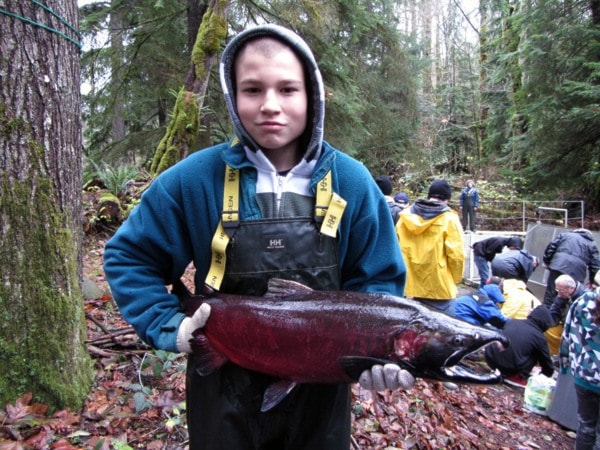The Youth and Ecological Restoration program takes youth out to work with local conservation and enhancement groups to learn about working with people who are helping the environment.
They are all required to do a presentation for a community group on completion of the program. One youth’s presentation was for St. Joseph’s Hospital's Transitional Care Unit.
Here are 13-year-old Daniel Perry’s presentation notes:
"I kinda figured that by doing this program I could get away from school for 20 hours. It was going up creeks, teaching me about salmon, trying on chest waders and learning about owls and other birds. I want to learn about nature and how the creeks work.
"The first thing we did was go to Millard Creek and check the fish for eggs and did a lot of talking about fish habitat. Then we put on chest waders and walked up Morrison Creek. It was cool because I got to see oyster mushrooms on the way up.
"We walked up Morrison Creek to check on the water levels and to check if there was coho salmon. No coho salmon were in the creek.
"We went to Merville to see the sick and injured birds at Mountainaire Avian Rescue Society (MARS). I saw a couple of barred owls, a red tail hawk, great horned owl, turkey vultures, Muscovy ducks, a seagull and a snowy owl. When I got to see the snowy owl in the building I had to be quiet because you should when an opportunity like this is presented to you.
"The snowy owl was very pretty and fluffy looking. The owl was starving because of an over population in the Arctic. They’re young and starving to death. MARS has had six snowy owls and four have died so far.
"I also got to go in an eagle’s pen; the bald eagle was very large and had very large wings. Only people who work closely with the birds can go in their cages and be close to them. The public is not granted access to their cages or pens except for the educational birds.
"You have to do maintenance at MARS to keep it from going out of commission and to keep getting funds to help the bird population stay around longer.
"We went up to Oyster River to do a coho egg take. The first thing I got to do was feed the coho fry. The second thing I got to do was dip netting the male and the female coho to check to see if they were ready to spawn. About 20 males and 10 females were ripe.
"It is good to have two males to fertilize the eggs of a female because then there is a better gene pool for survival of the species so they don’t go extinct.
"We did another coho egg take at Millard Creek. The facility was a lot smaller than Oyster River. The Oyster River group has been going for 30 years and Millard for about 15 years.
"When we did the egg take at Millard Creek we all had to set up a tent to protect the eggs from water. The eggs can only be fertilized in a few seconds otherwise the water hardens the eggs. We had five males and two females.
"I loved the owl rescue facility the most because the owls are pretty and very fluffy, especially the great horned owl. He was quite the eavesdropper. When I would go around his cage to rake up more leaves he would try and look around the corner to find me.
"I liked the program because it taught me about how to handle the coho salmon when they’re spawning up the rivers and creeks in our community. It benefits me and the community because it is teaching me about nature and job skills. By working together with people and nature, we can accomplish so many things."
— Youth and Ecological Restoration
